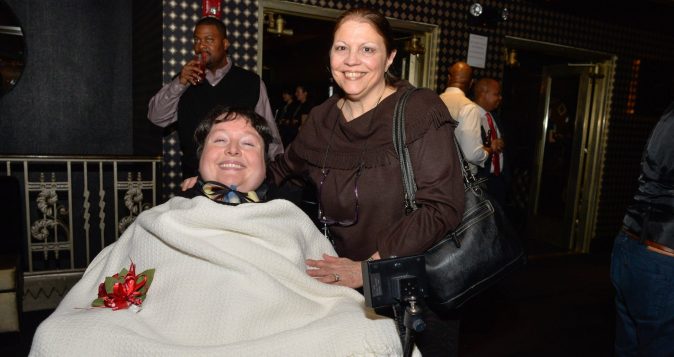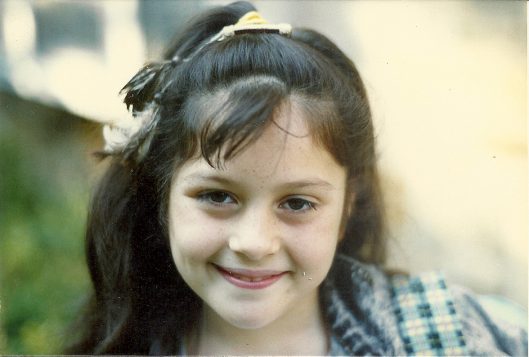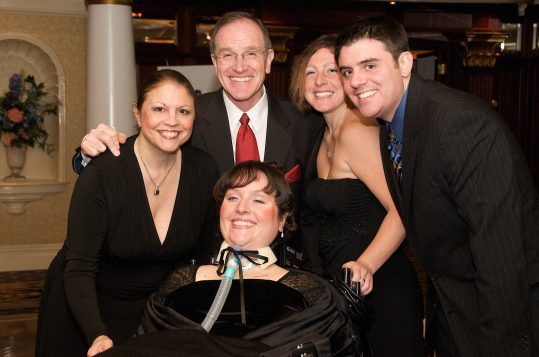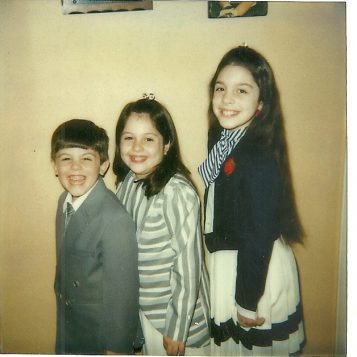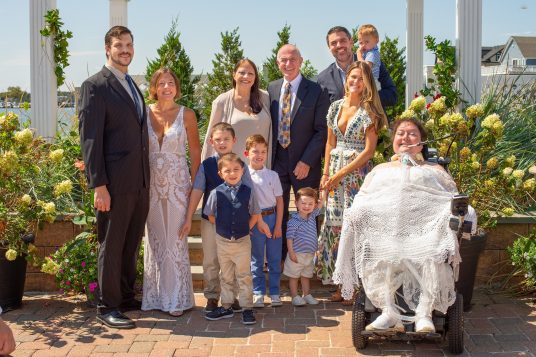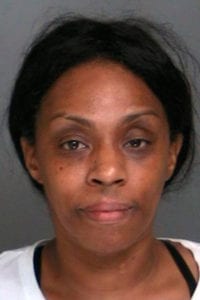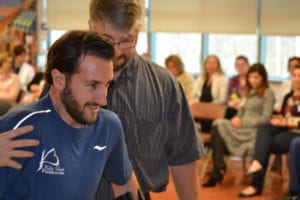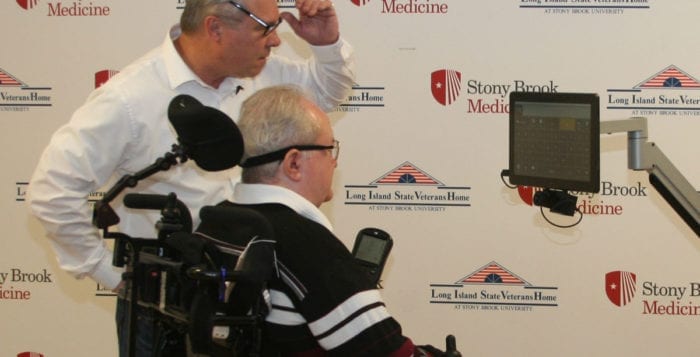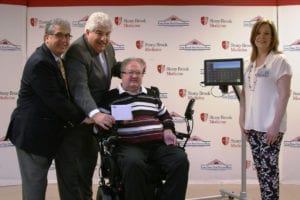Prepared by Daniel Dunaief
Brooke Ellison, 45, a pioneering disabilities advocate whose abilities with words and compassion far outdid her disability, died on Sunday, February 4.
Ellison was a tenured Associate Professor in the School of Health Professions in the Department of Health Sciences at Stony Brook University.
A resident of Stony Brook, Ellison was returning home from Murphy Junior High School as an 11-year old when she was struck by a car. The accident, which paralyzed her from the neck down, didn’t deter her budding academic interest or her ambitions.
As soon as she woke from the accident, she insisted she not fall behind in school.
With her mother Jean at her side throughout her education, Ellison became the first quadriplegic to graduate in 2000 from Harvard College, where she received magna cum laude honors in cognitive neuroscience and gave the class commencement speech.
Ellison earned a Master’s in Public Policy in 2004 from Harvard’s Kennedy School of Government and received her PhD in sociology from Stony Brook University in 2012.
A passionate advocate for accessibility and opportunity for the disabled, Ellison conducted research on the ethics and policy of science and health care.
Her mission “was to turn what happened to her into a [way to] help people who are handicapped achieve independence,” said Miriam Rafailovich, Distinguished Professor in Material Science and Engineering.
Ellison wrote two books about her life. The first, called “Miracles Happen” became a movie directed by Christopher Reeve titled “The Brooke Ellison Story.” More recently, Ellison published “Look Both Ways.”
Jean Ellison said her daughter felt her recent book was one of her most important contributions. Knowing she was in failing health after surviving three bouts with sepsis over the last year and a half, Brooke Ellison felt a sense of urgency to share her experiences.
“She poured out [her life] to the universe through this book,” said Jean Ellison.
While Ellison died young, she lived for over 33 years after the accident, which is well above the seven years the medical community expected at the time for someone on a ventilator.
‘Deep sadness’
Ellison served on several committees and boards, including the Board of the Directors of the New York Civil Liberties Union and the search committee for a president of Stony Brook.
In a letter to the campus community, President Maurie McInnis, who expressed her “deep sadness” for Ellison’s passing, recounted how Ellison was one of the first people she met on campus.
“Her legacy at Stony Brook and beyond is defined by passionate advocacy for inclusive education, healthcare and disability rights,” McInnis wrote in a letter to the campus community. “She helped alert me and others to our blind spots and offered many ideas for making this campus more inclusive and welcoming.”
Ellison was recently teaming up with students using drones and artificial intelligence images to map the topography of Stony Brook.
“To go from one building to the next looks like a straight pathway, but at the end, a one-inch drop, which is not encoded anywhere” could be a huge problem for someone in a wheelchair, said Rafailovich.
Ellison’s students asked her what she would want a robot near her that she could control to do. She suggested a hand she could control that could turn the pages of a book.
Ellison was working with the Federal Emergency Management Agency to ensure that people with disabilities who need power for ventilators or other equipment receive immediate attention after power disruption.
“She noticed during Hurricane Sandy that emergency workers had no idea where people who were on life support were during two weeks,” said Rafailovich.
Ellison was working with the state to get a new system where people on life support could receive help quickly.
Ellison had planned to do a fellowship at the Harvard Kennedy Carr Center for Human Rights Policy.
Caring for everyone
In addition to her focus on helping people with disabilities achieve independence, Ellison served in many capacities at Stony Brook, including as the Director of the Center for Community Engagement and Leadership Development.
Among her many efforts, Ellison also ran for election in 2006 for the New York State Senate, where she lost to republican incumbent John Flanagan.
Ellison was a committed educator who asked students before they met her in an ethics class to describe what they thought would make a life not worth living. Students suggested this would include not being able to do things they needed, needing care from someone else, or living on life support.
At the end of the semester, she asked the same question.
“They thought if they were on life support or if they had to have someone take care of them, maybe it could be done,” Jean Ellison said. “Their whole outlook changed.”
Senior Sabah Bari, who is a Health Science student, appreciated how Ellison spent the first 15 minutes of class asking how students were doing. Describing Ellison as “one of the most influential people I’ve gotten to know,” Bari plans to dedicate her pursuit of a master’s in public health to Ellison.
Stacy Gropack, Dean of the School of Health Professions explained that the school is eager to make sure students are doing well and feeling well at all levels.
“Many of our instructors do that,” Gropack said, but “Ellison in her position took it to a different level. She was always very concerned that students were in the right place and were healthy. She made sure students had the capacity to succeed at all levels.”
A dedicated family
Ellison received considerable ongoing support from her family.
Jean Ellison served numerous roles, from getting up at 3:45 am each day to get her dressed to driving her to ensuring her slides were ready and in order for her presentation. It took six hours from the time Ellison awoke until she was ready to leave.
Jean Ellison is “probably one of the most dedicated, strongest women I know,” said Gropack. Ellison “could not have accomplished what she did without [her mother] on all fronts.”
Mathias Risse, Berthold Beitz Professor in Human rights, Global Affairs and Philosophy at the Harvard Kennedy School, recalled how he taught an ethics class that included Ellison in the fall of 2002.
Ellison was “one of the most talented students in the class,” Risse wrote in a memorial to his former student. “Jean was there with her, every time, and she was as much a member of the [class] of 2004 as [Ellison] was herself.”
When the two of them were on campus, “everyone knew who they were, mother and daughter,” Risse wrote.
Ellison’s father Ed and her siblings Kysten and Reed provided important, meaningful and ongoing care for her.
“One of us had to be with her 24 hours a day, seven days a week,” said Ed Ellison. “Jean and I feel very blessed to have had the opportunity to help her do what she wanted to do. It was a life well-lived.”
Ellison adored her family and, in particular, her five nephews, who not only returned her affection, but were also fiercely protective of her.
One of Ellison’s nephews had a cat that she almost ran over in her wheelchair. She asked her students to help her design a 360 degree camera so she could survey the perimeter when the cat was nearby.
“That’s the kind of independence she wanted,” said Rafailovich.
Ellison shared affection with her family and friends by blowing kisses frequently. Her father stroked her cheek and lifted her up out of her chair and put her arms around his neck.
“The love she had for everyone oozed out of her,” Jean Ellison said. Her daughter “constantly told people how much she loved them.”
Before the accident, Ellison had been a ballet dancer. She would sometimes dream of herself dancing.
“We both like to think that she’s dancing now,” said Jean Ellison.
Stem cell research
Ellison became a powerful voice in some of the earlier battles in 2000 over stem cell research. Stem cells are undifferentiated cells that could one day help in the treatment and care of people with neurological limitations.
Ellison, who founded the Brooke Ellison Project, helped establish the New York State stem cell research organization, which provided research funding outside of the federal level.
Ellison and the Christopher Reeve foundation “had the courage to put [state funding] in place,” said Rafailovich. “She saw stem cell research as the key if we’re ever going to regenerate nerves.”
Ellison recognized any new treatment wouldn’t happen immediately, but wanted to help people in the future who were dealing with similar challenges.
Ellison is featured in the upcoming documentary “Super/Man: The Christopher Reeve Story,” which was recently shown at the Sundance Film Festival.
Ellison served as a board member on the Empire State Stem Cell Board, which designed New York State’s stem cell policy from 2007 to 2014.
In 2017, Ellison also served on the board of directors of the New York State Civil Liberties Union and, in 2018, was chosen as a political partner for the Truman National Security Project.
“We count ourselves incredibly lucky to have known her and are extraordinarily humbled by who she was and what she accomplished in her short life,” NYCLU Executive Director Donna Lieberman wrote in an email. “I have benefited immeasurably from [Ellison’s] wisdom and friendship, and I am especially grateful or her patience and determination in helping the NYCLU to better understand and advocate for the rights of people with disabilities.”
Leaders from the Truman National Security Project, which is a diverse nationwide community of leaders united with the goal of developing smart, national security solutions that reinforce strong, equitable, effective and non-partisan American global leadership, expressed their appreciation and admiration for Ellison’s contributions.
Ellison was a “visionary, leader, teacher, and, most importantly, a true friend to us and the disability community. [Ellison’s] eloquence captured the heights and depths of the disabled experience – beauty, pain, nuances, and silver linings – while pushing society’s boundaries of a more inclusive and dynamic world. Amongst [Ellison’s] vast list of accomplishments and accolades, her kindness and strength touched everyone she met,” wrote Jessica Gottsleben and Kristin Duquette, TruDisability Experts, in a statement.
Ellison thought well outside of her wheelchair and outside of the proverbial box.
In the first day of class, Bari recalled how Ellison asked students to think about the character Thanos from the Marvel series.
Bari recalled wondering, “are we in the right class? Where is she taking us?”
Throughout the class, Bari suggested that she and her fellow students rethought numerous aspects of their lives.
In her own words
In the introduction to her book “Look Both Ways,” which people can hear Ellison read on YouTube or on her web site BrookeEllison.com, she shares her life and perspective.
|
“People living with disability are celebrated yet rejected, are the objects of both praise and of ridicule, and are heralded for their understanding of challenge, while often left to battle those challenges on their own,” she wrote.
Ellison continued, “the lens from which I view the world is not one of disability, but rather one of humanity touched by disability, which serves to heighten the lessons fundamental to our lives: those of adaptation and problem solving, leadership and growth, compassion and hope. These are the lessons of disability. These are the lessons of life.”
Funeral
Ellison is survived by her parents Ed and Jean Ellison, her sister Kysten Ellison and her husband David Martin, their sons Carter and Harrison, her brother Reed Ellison and his wife Ellen Ellison and their three sons Jamie, Oliver and Theodore.

